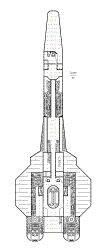Catalog Summary
USP
YF-11366C1-000000-00000-0 MCr 123.060 130 Tons
Bat Bear Crew: 1
Bat TL: 13
Cargo: 1.300
Fuel: 46.800
EP: 7.800
Agility: 5
Fuel Treatment: Fuel Scoops and On Board Fuel Purification
Architects Fee: MCr 1.231
Cost in Quantity: MCr 98.448
Detailed Description
HULL
130.000 tons standard, 1,820.000 cubic meters, Needle/Wedge Configuration
CREW
Pilot (1)
ENGINEERING
Jump-3, 6G Manuever, Power plant-6, 7.800 EP, Agility 5
AVIONICS
Bridge, Model/3fib Computer
HARDPOINTS
None
ARMAMENT
None
DEFENCES
None
CRAFT
None
FUEL
46.800 Tons Fuel (3 parsecs jump and 28 days endurance)
On Board Fuel Scoops, On Board Fuel Purification Plant
MISCELLANEOUS
2.0 Staterooms, 1.300 Tons Cargo
USER DEFINED COMPONENTS
None
COST
MCr 124.291 Singly (incl. Architects fees of MCr 1.231),
MCr 98.448 in Quantity
CONSTRUCTION TIME
45 Weeks Singly, 36 Weeks in Quantity
COMMENTS
 Click for full-size image (600x1500) |
|---|
The Hughes was designed and commissioned by Baroness Cynthia Hayes, an avid pilot and yacht racer. After entering the Hughes in the annual Capital Tour Run (a point to point held in the Core) and winning, the rights to the design were sold to a small manufacturing firm on the Baroness's homeworld. The firm, Ukena Lines, produced 173 Hughes-class yachts between 963 and 1106. No further orders have been placed with the firm since 1106 but plans and spec sheets are kept on hand in case anyone wishes to order one.
The long, sleek needle hull is designed for efficiency and speed not luxury. While the ship is quite capable of being run by one individual, Baroness Hayes was not as much of an engineer as she was a pilot and navigator. Her noble bearing would never of allowed for her to share a stateroom with her racing engineer (a family retainer and retired navy petty officer) so she installed a stateroom just aft of the engine room. The unique feature of this room is its modular design. The room displaces the full 54 cubic meters instead of allowing for the typical practice of dividing the allocated tonnage to room and living space. The room amenities are designed to fold into the wall and the aft bulkhead can open to space. The purpose for this was to appease the whims of the Baroness's lover who was (in addition to being a superb engineer) was an avid light sailor. When he was aboard ship the stateroom was converted to carry a small deployable solar sail (and he shared the Baroness's stateroom, much to her family's distress).
Today there are numerous Hughes-class ships still plying the space lanes. Many are still used for racing but a number have found there way into the hands of smugglers and other couriers in need of high speed, low mass ships. The spare stateroom once designed to allow for the deployable sail is used as a small cargo bay. Such ships usually convert the small 1 ton cargo area (normally used for supplies) into fire control for a retrofitted turret.
 Freelance
Traveller
Freelance
Traveller